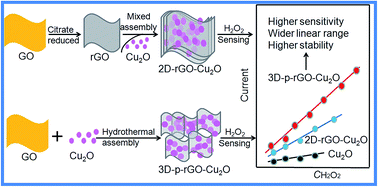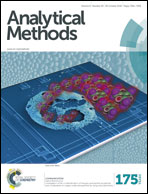Facile preparation of a three-dimensional macroporous graphene wrapped cuprous oxide composite by one-step hydrothermal assembly for stable and sensitive hydrogen peroxide detection
Abstract
In this study, a facile one pot hydrothermally induced self-assembly approach was proposed to prepare a novel three-dimensional (3D) macroporous graphene wrapped cuprous oxide composite (3D-p-rGO–Cu2O) for the stable and sensitive electrochemical detection of hydrogen peroxide (H2O2). The composite was characterized by scanning electron microscopy (SEM), energy dispersive X-ray spectroscopy (EDS), Raman spectroscopy and electrochemical methods. 3D-rGO could reduce the aggregation of two-dimensional graphene (2D-rGO) nanosheets and increase the surface area, while the connected macroporous structure enhances the electron and mass transport. The synergistic interaction between Cu2O and 3D porous rGO makes 3D-p-rGO–Cu2O a good electrocatalyst towards the reduction of H2O2. A nonenzymatic sensor for H2O2 based on 3D-p-rGO–Cu2O shows a linear response range from 0.5 μM to 10.17 mM, with a detection limit of 0.2 μM (S/N = 3), which shows the advantages of higher sensitivity, higher stability and wider linear range than those sensors based on Cu2O or 2D-rGO supported Cu2O particles (2D-rGO–Cu2O). Our results indicate that hydrothermally induced self-assembly is a good alternative approach to prepare a 3D graphene–nanomaterial composite/hybrid, which may have great potential in fabricating advanced electrochemical sensors.


 Please wait while we load your content...
Please wait while we load your content...